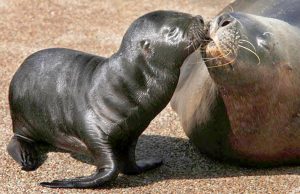Latest update April 11th, 2025 9:20 AM
South American sea lion (Otaria flavescens)
Sep 29, 2019 Interesting Creatures in Guyana, News
The South American sea lion (Otaria flavescens, formerly Otaria byronia), also called the southern sea lion and the Patagonian sea lion, is a sea lion found on the Chilean, Ecuador, Peruvian, Uruguayan, Argentine and Southern Brazilian coasts.
It is the only member of the genus Otaria. Its scientific name was subject to controversy, with some taxonomists referring to it as Otaria flavescens and others referring to it as Otaria byronia. The former eventually won out, although that may still be overturned. Locally, it is known by several names, most commonly lobo marino (es)/lobo marinho (pt) (sea wolf) and león marino (es)/leão marinho (pt) (sea lion).
The South American sea lion is perhaps the archetypal sea lion in appearance. Males have a very large head with a well-developed mane, making them the most lionesque of the eared seals. They are twice the weight of females. Both males and females are orange or brown coloured with upturned snouts. Pups are born greyish orange ventrally and black dorsally and moult into a more chocolate colour.
The South American sea lion’s size and weight can vary considerably. Adult males can grow over 2.73 m (9 ft) and weigh up to 350 kg (770 lb). Adult females grow up to 1.8–2 m (6–7 ft) and weigh about half the weight of the males, around 150 kg (330 lb). This species is even more sexually dimorphic than the other sea lions.
The South American sea lion is found along the coasts and offshore islands of South America, from Peru south to Chile in the Pacific and then north to southern Brazil in the Atlantic. Sea lions prefer to breed on beaches made of sand, but will breed on gravel, rocky, or pebble beaches, as well. They can also be seen on flat, rocky cliffs with tide pools. Sea lion colonies tend to be small and scattered, especially on rocky beaches. The colonies make spaces between each individual when the weather is warm and sunny. They can also be found in marinas and wharves, but do not breed there.
Sea lion mothers remain with their newborn pups for nearly a week before making a routine of taking three-day foraging trips and coming back to nurse the pups. They act aggressively to other females that come close to their pups, as well as alien pups that try to get milk from them. Pups first enter the water at about four weeks and are weaned at about 12 months. This is normally when the mother gives birth to a new pup. Pups gradually spend more time in the near shore surf and develop swimming skills.
South American sea lions are observed to make various vocalizations and calls which differ between sexes and ages. Adult males make high-pitched calls during aggressive interactions, barks when establishing territories, growls when interacting with females, and exhalations after antagonistic encounters. Females with pups make a mother primary call when interacting with their pups, and grunts during aggressive encounters with other females.
Mating occurs between August and December, and the pups are born between December and February. Males arrive first to establish and defend territories, but then switch to defending females when they arrive.
South American sea lions consume numerous species of fishes, including Argentine hake and anchovies. They also eat cephalopods, such as short fin squid, Patagonian squid, and octopus. They have even been observed preying on penguins, pelicans, and young South American fur seals. South American sea lions may forage at the ocean floor for slow-moving prey or hunt schooling prey in groups, depending on the area. When captured, the prey is shaken violently and torn apart. South American sea lions have been recorded to take advantage of the hunting efforts of dusky dolphins, feeding on the fish they herd together. The sea lions themselves are preyed on by killer whales and sharks, and visited as a handy source of blood by common vampire bats. (Source: Wikipedia)
Share this:
- Click to print (Opens in new window)
- Click to email a link to a friend (Opens in new window)
- Click to share on Facebook (Opens in new window)
- Click to share on WhatsApp (Opens in new window)
- Click to share on Twitter (Opens in new window)
- Click to share on Pinterest (Opens in new window)
- Click to share on Pocket (Opens in new window)
- Click to share on Tumblr (Opens in new window)
- Click to share on Reddit (Opens in new window)
- Click to share on LinkedIn (Opens in new window)
Related
Similar Articles

The Glenn Lall Show|| April, 7th, 2025
Follow on Tik Tok @Glennlall
THE BLUNT OF THE DAY

Sports
Apr 11, 2025
-Thrilling action unfolds on Day Three Kaieteur Sports- The courts at the National Racquet Centre (NRC) were once again buzzing with intensity on Wednesday as Day Three of Moo’s National Junior...Features/Columnists
Protest against Commissioner of Information continues today
Kaieteur News- A protest organized against the Office of the Commissioner of Information, Charles Ramson SC, will continue... more
The U.S. “Joining” the Commonwealth: an unreasonable expectation
By Sir Ronald Sanders Kaieteur News- Recent media stories have suggested that King Charles III could “invite” the United... more
Publisher’s Note
Freedom of speech is our core value at Kaieteur News. If the letter/e-mail you sent was not published, and you believe that its contents were not libellous, let us know, please contact us by phone or email.
Feel free to send us your comments and/or criticisms.
Contact: 624-6456; 225-8452; 225-8458; 225-8463; 225-8465; 225-8473 or 225-8491.
Or by Email: [email protected] / [email protected]
Weekend Cartoon















